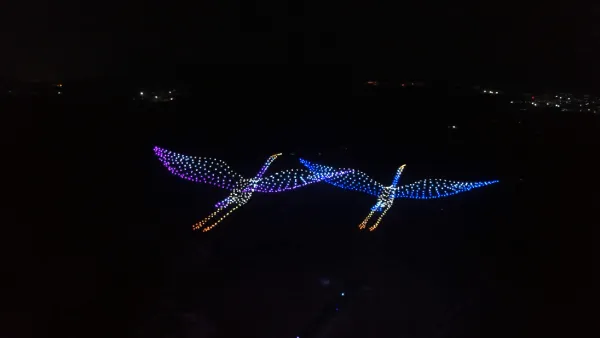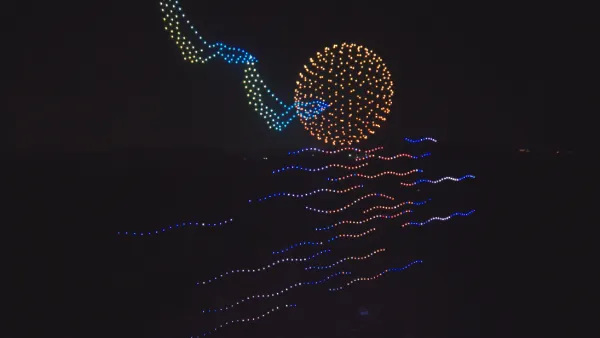How to Improve the Accuracy of Outdoor Drones For Light Show?
Light shows, especially those involving drones, have become increasingly popular in recent years, providing audiences with spectacular visual experiences. However, the success of such a show hinges on the precision and accuracy of the drones involved. In this blog post, HighGreat will share the various strategies and technologies that can be employed to improve the accuracy of outdoor drones for light shows, ensuring that your aerial performances are nothing short of perfect.
Understanding the Importance of Accuracy
Before diving into the specifics of improving drone accuracy, it's crucial to understand why it's so important. Outdoor drone light shows require a high level of precision to ensure that:
1. Synchronized Performance: Drones must move in perfect harmony to create cohesive patterns and effects.
2. Safety: Erratic movements can lead to collisions or accidents, putting both the drones and spectators at risk.
3. Visual Impact: Precise positioning is essential to maintain the visual integrity of the light show and avoid distracting or chaotic displays.
With these factors in mind, let's explore the various ways to improve the accuracy of outdoor drones for light shows.
GPS and GNSS Technology
Global Positioning System (GPS) and Global Navigation Satellite System (GNSS) are foundational technologies for drone navigation. By utilizing these systems, drones can accurately determine their position in real-time, which is crucial for maintaining formation and executing complex maneuvers.
Tips for GPS/GNSS Enhancement:
- Use Dual-Frequency GPS: This technology can reduce errors caused by signal interference, leading to more accurate positioning.
- Maintain Satellite Lock: Ensure that your drones maintain a strong connection to the satellites for continuous and reliable positioning data.
- Calibrate Regularly: Periodic calibration of GPS receivers ensures that any drift or inaccuracies are corrected.

Advanced Flight Controllers
Flight controllers are the brains of the drone, and investing in advanced models can significantly improve accuracy. These controllers often come with better algorithms for stabilization and navigation, which can translate to smoother and more precise flights.
Tips for Choosing the Right Flight Controller:
- Look for High-Precision Sensors: IMUs (Inertial Measurement Units) with gyroscopes and accelerometers are essential for maintaining stability and accurate positioning.
- Software Capabilities: Choose flight controllers with robust software that can handle complex flight paths and synchronization requirements.
- Customization Options: Advanced flight controllers often allow for customization, enabling you to tailor the drone's performance to your specific light show needs.
RTK and PPK Positioning Systems
Real-Time Kinematic (RTK) and Post-Processed Kinematic (PPK) positioning systems offer centimeter-level accuracy, which is ideal for intricate light shows. These systems correct GPS data in real-time or post-mission, respectively, to provide highly accurate positioning information.
Tips for Implementing RTK/PPK:
- Invest in Compatible Hardware: Ensure that your drones and ground control equipment are compatible with RTK or PPK systems.
- Maintain a Reliable Data Connection: RTK systems require a constant data link with a base station for real-time corrections.
- Understand the Limitations: While RTK and PPK offer superior accuracy, they can be affected by environmental factors or signal obstructions.
Advanced Software and Algorithms
Sophisticated software and algorithms can greatly enhance the accuracy of drone movements. These can include swarm intelligence algorithms, which allow drones to communicate with each other and adjust their positions accordingly, or machine learning algorithms that improve over time.
Tips for Utilizing Advanced Software:
- Swarm Algorithms: Implement swarm intelligence software to enable drones to work together seamlessly and adjust to each other's movements.
- Machine Learning: Utilize machine learning to refine flight paths and improve overall performance over time.
- Simulation: Use software simulations to test and perfect your light show routines before performing them live.

Environmental Considerations
Environmental factors can significantly impact drone accuracy. Wind, temperature, and humidity can all affect drone performance, so it's essential to take these factors into account when planning and executing a light show.
Tips for Managing Environmental Factors:
- Monitor Weather Conditions: Keep a close eye on weather forecasts and adjust your plans accordingly.
- Wind Management: Use wind-resistant drone designs and consider incorporating wind sensors to help drones adjust to changing conditions.
- Temperature Control: Ensure that your drones are operating within the recommended temperature range for optimal performance.
Regular Maintenance and Calibration
Regular maintenance and calibration are key to maintaining the accuracy of your drones. Over time, components can wear down or drift out of calibration, leading to less precise performances.
Tips for Maintenance and Calibration:
- Schedule Routine Checks: Establish a regular maintenance schedule to inspect and repair any damaged or worn components.
- Calibrate Sensors: Regularly calibrate sensors, such as the IMU and GPS, to ensure they provide accurate data.
- Update Firmware: Keep your drone's firmware up to date to take advantage of the latest improvements and bug fixes.
Pilot Training and Experience
While technology plays a significant role in drone accuracy, the skill and experience of the pilots controlling them cannot be overlooked. Well-trained pilots can adapt to unexpected situations and make real-time adjustments to ensure a successful light show.
Tips for Pilot Training:
- Simulator Training: Use drone simulators to train pilots in various scenarios and conditions.
- Hands-On Experience: Provide ample opportunity for pilots to gain practical experience with the drones.
- Continuous Education: Encourage pilots to stay updated on the latest drone technologies and best practices.
Conclusion
Improving the accuracy of outdoor drones for light shows is a multifaceted endeavor that involves leveraging advanced technologies, maintaining and calibrating equipment, and ensuring that pilots are well-trained and experienced. By implementing the strategies outlined in this blog post, you can significantly enhance the precision and reliability of your drone light shows, providing audiences with unforgettable experiences.

 Telephone No.Email
Telephone No.EmailMailbox number:marketing@hg-fly.com



